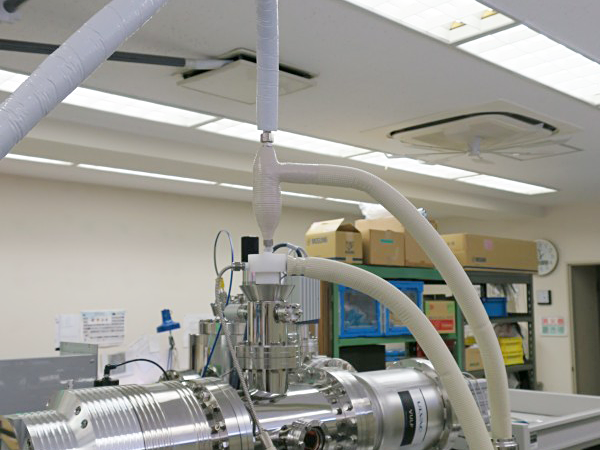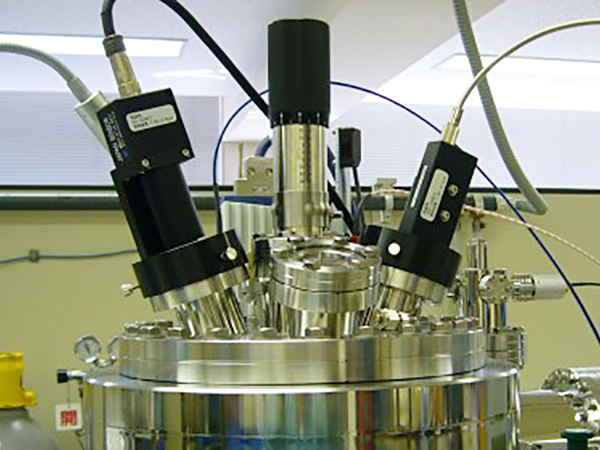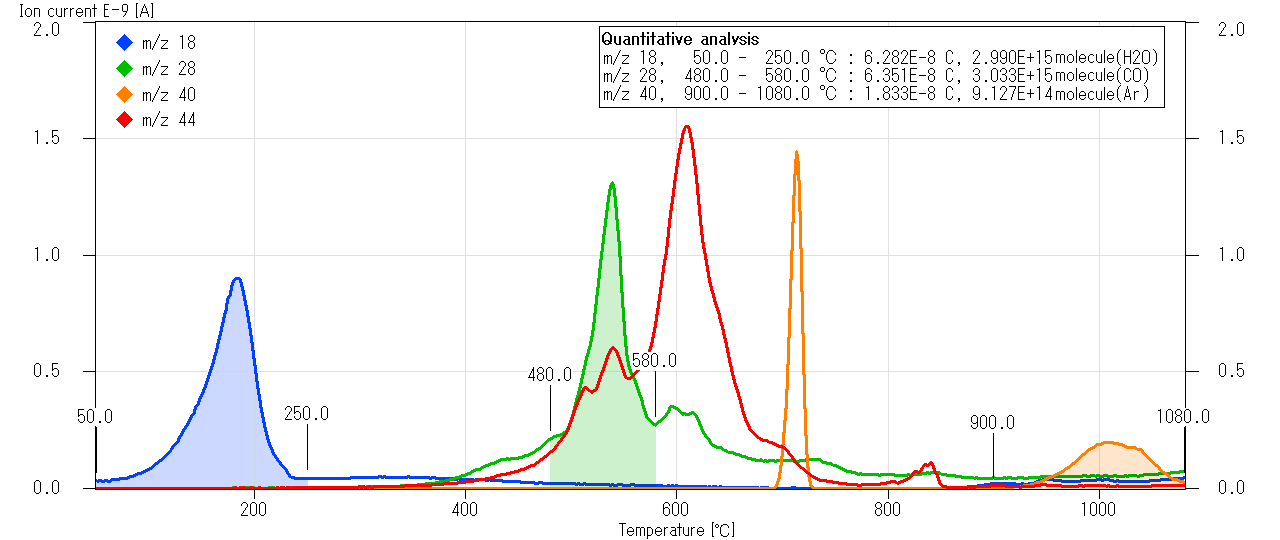Features
The thermal desorption analyzer IH-TDS1700 heats samples in an ultra-high vacuum using electromagnetic induction heating, and utilizes a quadrupole mass spectrometer (QMS) for real-time observation of molecules desorbed from the sample. The ultra-high vacuum enables high-sensitivity measurements with low background. Side reactions between the atmosphere and generated gases are suppressed, so the desorbed molecules from the sample can be observed under optimal conditions.
For metal samples with good heating efficiency, heating to temperatures above 1700 °C is possible. In addition, low temperature TDS measurement of diffusible hydrogen in steel, a cause of hydrogen embrittlement in steel materials, is also possible.
The main unit is automatically controlled by PLC (Programmable Logic Controller), and a touch panel is used for the interface.
*This instrument has been developed with support from the Ichimura Foundation for New Technology

Loadlock chamber
The load-lock chamber is essential for achieving high sensitivity and high-efficiency (high throughput) measurement. Our load-lock chamber and sample transfer mechanism enable quick insertion of only the sample into the analysis chamber under an ultra-high vacuum.
If there is no load-lock chamber, it is necessary to expose the analysis chamber to ordinary atmosphere each time the sample is exchanged. A large amount of air (mainly water) is drawn into the analysis chamber when it is exposed to ordinary atmosphere, making it necessary to perform evacuation for a long time to return to a suitable vacuum level.

Low-temperature TDS measurement of diffusible hydrogen in steel
Because it is possible to measure a cooled steel specimen, diffused hydrogen is prevented from escaping and can be quantified with high accuracy, even the diffusible hydrogen of BCC steel, which has a large hydrogen diffusion coefficient.
If frost adheres to the cooled steel specimen, the desorption of this frost can affect the hydrogen signal and cause an error in the measurement of the diffusible hydrogen (the uncertainty increases). The cold trap (option) of IH-TDS1700 can trap frost to minimize the influence of the frost, enabling acquisition of desorption spectra of diffusible hydrogen with less distortion.

Quantification of desorbed gases
The data processing program enables quantitative analysis of the desorbed gases. To perform quantitative analysis of the desorbed gases, it is necessary to regularly calibrate the sensitivity of the mass spectrometer.
Sensitivity calibration using standard leaks requires preparation of an expensive standard leak for each type of gas, and the calibration procedure is time-consuming. In addition, strict health and safety management is required when standard leaks of poisonous gases are used.
The current quantification program enables quicker, easier, and safer quantitative analysis of the desorbed gases than the method using calibration with standard leaks. Highly accurate results can be obtained simply by periodically measuring the NIST-traceable hydrogen standard sample produced by ESCO. The sensitivity correction method we have developed can correct the sensitivity even for gases other than hydrogen, and it has been verified that the results obtained are in good agreement with quantitative results obtained using calibration with a standard leak according to the National Institute of Advanced Industrial Science and Technology (AIST) standards.
Technology
- Thermal Desorption Spectroscopy method
- Quantification method
Japanese Only
昇温脱離分析法
昇温脱離法の解析に使用される脱離モデルや活性化エネルギの求め方についての参考資料です。
※Japanese PDF file opens.
Japanese Only
昇温脱離分析装置における定量
この資料は平下・内山の分析化学での報告 「N.Hirashita and T.Uchiyama, BUNSEKI KAGAKU, 43 , 757 (1994)」に基づいています。
昇温脱離分析装置で測定した昇温脱離スペクトルから、脱離ガスの定量を行なうことができます。
測定チャンバーの排気速度が脱離ガスに起因する測定チャンバーの圧力変化に比べて十分に大きいとき、脱離ガス成分の分圧の変化は単位時間あたりの脱離量(脱離速度)に比例します。
質量分析計ではイオン電流と分圧は比例するので、結局イオン電流と脱離速度が比例することとなり、イオン電流を積分した面積強度から全脱離量を計算することができます。
既知量のH+を注入したSi試料を用いて面積強度と脱離量の比例係数を求めておけば、様々な試料についてm/z2の面積強度から水素の脱離量を決定することができます。
また水素以外の分子については、水素と目的分子のイオン化難易度、フラグメンテーションファクター、透過率などのパラメーターから目的分子についての比例係数を計算することができます。 この比例係数を使えば水素以外の分子の定量も可能です。
※Japanese PDF file opens.
Option
 Liquid nitrogen automatic feeder
Liquid nitrogen automatic feeder Radiation thermometer
Radiation thermometer
Consumables
| Standard sample | |||||
|---|---|---|---|---|---|
| F-remover | F-remover | ||||
| Heating items | Alumina crucible | Holder base | Quartz tube-A(medium) | Quartz tube-A(long) | |

